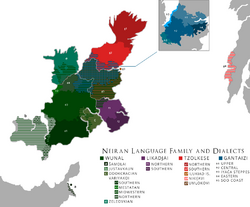Neiran languages
| Neiran | |

| |
| Map detailing the languages and major dialects of the Neiran language family | |
| Ethnicities | Neiran peoples |
| Geographic distribution | Originated in continent of Neira, now additionally spoken in northeastern Cymlun and western Urcinne |
| Linguistic classification | Language isolate[1] |
| Proto-language | Proto Central Cymluni (proposed) |
| Speakers | 55,520,100[2] |
| [Source] | |

|
Work in progress
This article is currently still being written. The author(s) apologise for the inconvenience.
|
The Neiran languages are a language family that evolved from the Old Nerian language by the second century BCE, evolving first into Wuiybak in the south and Tzoelbak in the north of the continent, before gradually splintering to the modern day languages of Gantaizi, Likadjai, Tzolkese, and Wunal between the ninth and eleventh centuries C.E.
History[edit | edit source]
In contemporary, mainstream linguist opinion the Neiran language family is considered to be a language isolate, which emerged and developed thousands of years ago parallel to the mother tongues of the neighbouring Cymlun. This assumption has largely been supported by the apparent uniqueness of the Neiran languages, specifically with their employment of prepositional and adjectival articles and a tense system unlike anything seen in other world languages, as well as its use of phonemes seemingly unrelated to neighbouring languages.
The modern advancement of anthropological and linguistic study however has put this assumption in question. In particular, the languages of the Central Cymluni language family and even the ethnic groups of the central Cymlun region have been marked as showing frequent similarities to the Neiran peoples, convincing several linguists to propose a Proto-Central Cymluni language family that includes the Seonmic, Abata and Neiran language groups.
Under this hypothesis, in the process of splitting from the theoretical mother tongue it shares with all other Central Cymluni languages, the Neiran language family seems to have retained a fluidity of word classes typical of most other Central Cymluni languages, contrasted with the nearby Upcymlu-amleian languages with few words being categorised in more than one word class. Its agglutinative format also resembles the synthetic and polysynthetic behaviour of the other languages, most especially that of Seonmi, however with word class established by word order and the incidental use of word-class exclusive suffixes - such as tense, case or plural - as opposed to the mandatory word class establishing suffixes used in the other Central Cymluni languages.
However it has since splitting assumed a nominative-accusative morphosyntactic alignment, similar to the Upcymlu-amleian languages, as opposed to the split ergative alignment of most Central Cymluni languages. Neiran languages have also seemed to have either developed a system of noun cases, or has retained them from the mother tongue, with all widely spoken Central Cymluni languages having lost them through the passage of time. Limited noun case systems do however manifest in several minor dialects in Anagini and Icoratha, supporting the hypothesis.
Notes[edit | edit source]
| Languages | |
|---|---|
| Families | |
| Language families | Central Cymluni · Ewigic · Lowcymlu-urcinnan · Neiran · Upcymlu-amleian · Yumeran |
| Languages | |
| Major languages | Abata · Amulni · Atraelish · Barva · Cesmelan · Etruarac · Flaigalish · Gakknir · Gashaorhieli · Jovaran · Mahleka · Mainathan · Mordrasi · Mukegani · Pelannician · Ruuvatthan · Seonmi · Tzolkese · Umura · Varlish · Virassian · Wunal · Yashurhieli |
| Minor languages | Šamolai |
| Misc. | |
| Grammar | Amulni · Seonmi · Virassian · Wunal |
| Word lists | List of Seonmi words and phrases · List of Wunal words and phrases |
- ↑ According to mainstream opinion, the languages of the Neiran continent, whilst related to one-another, demonstrate few supportable links to other human languages. Thus, the languages' mother tongue is regarded as a language isolate, and is simply categorised as part of the "Neiran" language family.
- ↑ Conservative estimate, c. 1900